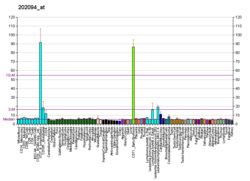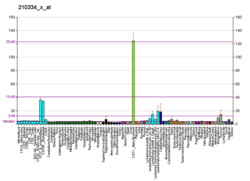Top Qs
Timeline
Chat
Perspective
Survivin
Mammalian protein From Wikipedia, the free encyclopedia
Remove ads
Survivin, also called baculoviral inhibitor of apoptosis repeat-containing 5 or BIRC5, is a protein that, in humans, is encoded by the BIRC5 gene.[5]
Survivin is a member of the inhibitor of apoptosis (IAP) family. The survivin protein functions to inhibit caspase activation, thereby leading to negative regulation of apoptosis or programmed cell death.[6] This has been shown by disruption of survivin induction pathways leading to increase in apoptosis and decrease in tumour growth. The survivin protein is expressed highly in most human tumours and fetal tissue, but is completely absent in terminally differentiated cells.[7]
Remove ads
Structure
Survivin is distinguished from other IAP family members in that it has only one baculoviral IAP repeat (BIR) domain. The protein is 16.5 kDa large and is the smallest member of the IAP family.[8]
Function
Survivin is expressed in a cell cycle-dependent manner, with highest levels in the G2/M phase. It localizes to the mitotic spindle during cell division and interacts with tubulin.[9][10] Survivin plays important roles in regulating mitosis, inhibiting apoptosis, and promoting angiogenesis.[10][11]
Role in cancer
Survivin is highly expressed in most human cancers but is rarely detectable in normal adult tissues.[7] Its overexpression in tumors correlates with increased drug resistance, reduced apoptosis, and poor patient prognosis. The aberrant regulation of survivin in cancer cells makes it an attractive target for cancer therapy.[12]
Several approaches targeting survivin are being investigated as potential cancer treatments, including:
- Antisense oligonucleotides to inhibit survivin expression
- Small molecule inhibitors of survivin function
- Immunotherapy approaches using survivin as a tumor-associated antigen
- Combination therapies to sensitize cancer cells to apoptosis by inhibiting survivin
Interactions
Survivin has been shown to interact with:
References
Wikiwand - on
Seamless Wikipedia browsing. On steroids.
Remove ads








